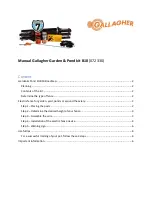
Page 14 of 22
ITS-90 Isothermal Towers Iss.07 – 05/14
Changing the Length of the Melt Plateau
By setting the controller 0.1°C above the melt temperature you will obtain a melt up to 30 hours 0.2°C will give you a
typical 15 hour melt etc.
Getting a Freeze
Isotowers can be used as a melt or a freeze point apparatus. The melt is arrived at more quickly and using a 24 hour
timer and allows a melt to be available all day every day.
The freeze curve is slightly flatter in temperature than the melt and some of you may wish to use the Isotower during
its freeze.
Firstly melt the cell and set the controller 2°C above the melt.
DO NOT set the controller more than 2°C above the melt. There is an over-temperature trip inside the Isotower
preset to 4°C above the melt to protect the heat siphon. Should you trip the unit you will need to contact Isotech for
further instructions.
NEVER change the trip temperature!
Leave the Isotower for an hour before resetting the controller temperature 0.1 to 0.2°C below the freeze. Monitor
the temperature in the cell and when it dips below the freeze temperature remove the monitor and in succession
introduce two cold rods, each for two minutes. Replace the monitor which should quickly achieve the freeze
temperature. Calibration of the Units Under Test (UUT) can commence, each UUT will freeze some metal and so
shorten the freeze time and so if a number of thermometers are to be calibrated they should be pre-warmed.
Certification
The unique feature of the Isotower is that it is complete. A certificate such as a UKAS certificate includes the
uncertainties of not just the cell but also the apparatus and immersion characteristics of the UUT. This reduces the
overall uncertainties of your laboratory and simplifies the task of calculating uncertainties, which in turn improves
confidence in your measurements.








































